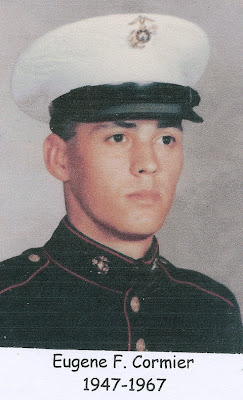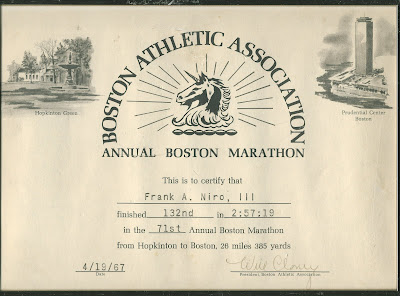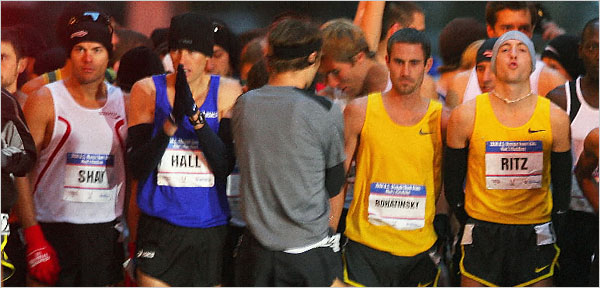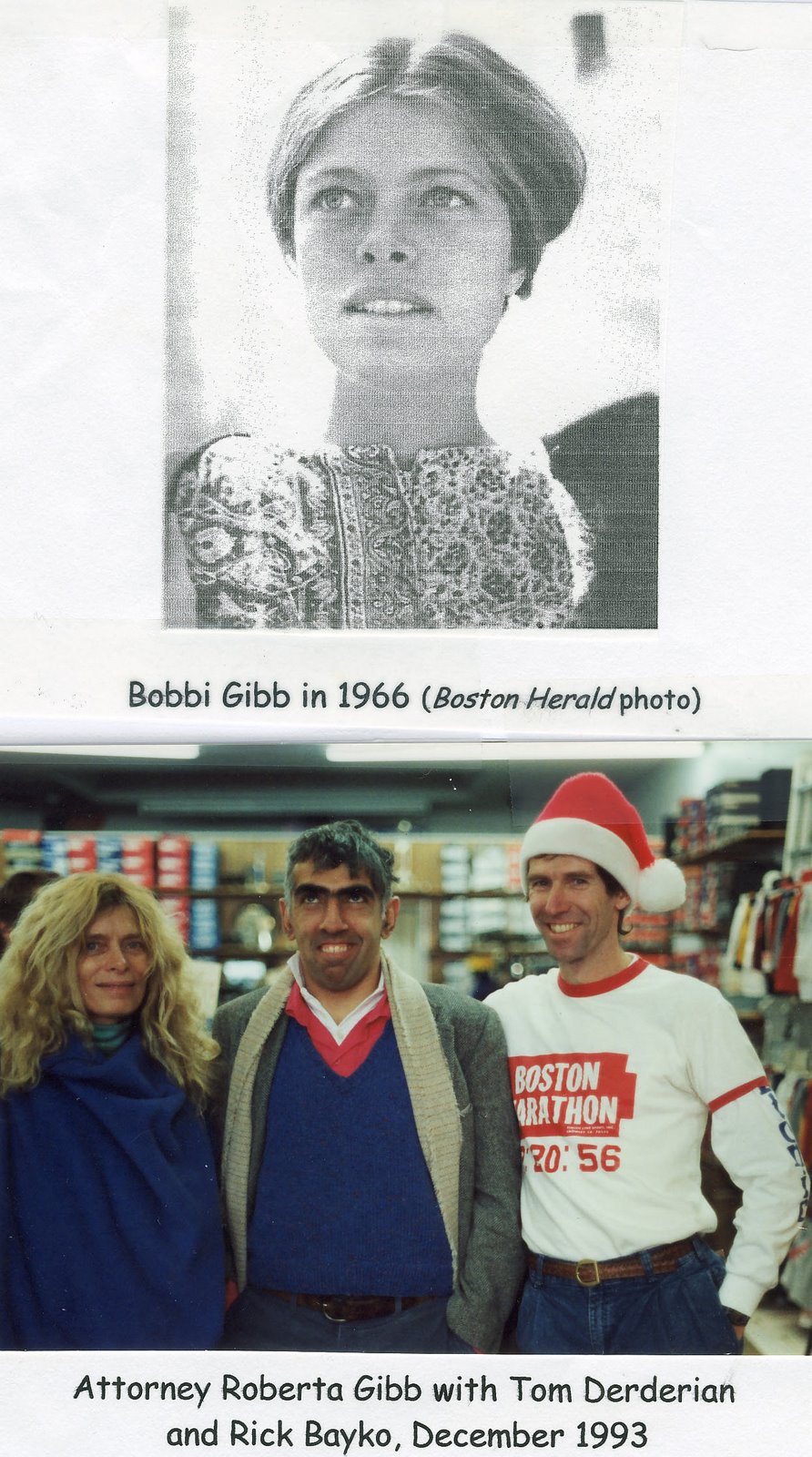As always, your comments and suggestions for improvement can be sent directly to the author at ChessSafari@yahoo.com.
 Frank Niro, on his 18th birthday, September 28, 1966
Frank Niro, on his 18th birthday, September 28, 1966Unlike the previous year, the 1967 Boston Marathon was run on a chilly, drizzly, windy day. It was a tough day for the runners and especially miserable for spectators. Nevertheless, a 40-year-old housewife and mother stood near the 14-mile marker in front of Wellesley High School counting the runners as they passed by. She was there, standing alone in the rain, for one reason. She didn’t drive a car but, luckily, her neighbor Antoinette Cormier offered to bring her to watch the race. Mrs. Cormier sat in her car with the heater on while the mother stood watching and counting, in a motionless gaze as each runner went by.
The first runner, New Zealander Dave McKenzie came by at 1:12 pm with American track star Tom Laris close on his heels. The remaining runners were spread out in the distance like an endless parade. One by one she counted the runners as they passed. She was prepared to count all 650 entrants if necessary. She needed to do it; she needed to find out if her son was still alive. It had been more than two months she last heard anything at all from him. Anxiously she thought, if he is alive he will be in this race and, if he is in this race, he will run by and I will see him.
As for me, I trained hard for the 1967 Boston Marathon, averaging more than ten miles per day during the previous twelve months. A large percentage of the training was in races. I completed six other full 26-mile marathons plus a 24-miler, and participated in my freshman cross country season at Bentley College. The highlight was my finish in Atlantic City in October 1966, where I became the youngest American runner to officially break three hours in an AAU sanctioned marathon. A few months later I was able to complete three full marathons in an eight day period. So I was quite confident that I would perform well here.
Despite the fact that I had temporarily withdrawn from college in order to save money for tuition, my Bentley teammates and I were given permission by the school to form its first track & field program. We competed in invitational events on the track as well as open road races. We entered a team in the Boston Marathon consisting of Ed Sicard, Bob Benoit, Jim Jeneral, Scott White and Dan Heary. Since I wasn’t currently enrolled in classes, I entered as a member of the North Medford Club.
The race started at noon. My Bentley teammates and I arrived at Hopkinton High School, about a mile from the starting line, before 10 am. Most of the veteran runners were accustomed to changing into their running clothes in the school’s locker room. This year would present a more difficult challenge because, for the first time, the race had more than 650 participants. Getting there early was a necessity.
The runners spilled over into the gymnasium. Nobody wanted to go outside because of the cold and rain. The distinct wintergreen smell of Bengay permeated the room. In one corner, the two Johnny Kelleys (John A. Kelly the ‘elder’ and John J. Kelly the ‘younger’) held court and posed for photographs. I was impressed by the fact that Johnny Kelley the younger, who had won the race ten years earlier in 2 hours, 20 minutes and 5 seconds, sported the biggest bunions I had ever seen. When he stood, his feet looked like sailboats crossing on the gym floor.
On the other side of the room, newspaper reporters were interviewing the contenders: Canadian champion Andrew Boychuk, American hopefuls Amby Burfoot and Tom Laris, New Zealand visitor Dave McKenzie and, through their interpreter, three Japanese runners.
I found a seat next to Ted Corbitt, an ultra-marathoner whom I had talked with at the Atlantic City and Cherry Tree marathons. He was accustomed to doing 50-mile races, and longer, which I found intriguing. Ted Corbitt liked regular marathons too and ran a lot of them. His best finish in the Boston Marathon was 6th place in 1952, the same year he competed for the United States in the Olympic games.
No sun block would be required this year, as it was in 1966, but Ted Corbitt was applying Vaseline liberally to his entire body. It made his skin shine like a new car. He looked every bit the superb athlete that he was, even at age 45. “Here, take some,” he said as held the jar within my reach. “Put some under your arms and on your nipples and anywhere else where there will be rubbing,” he said. “It prevents chafing. That’s important on a day like this.” So I did. I was getting advice from one of the best and I knew I could trust him.

Rick Bayko, Tom Derderian, Jim Conley and I started the race at the back of the pack. We were inexperienced and didn’t realize that it would take almost a minute after the gun to reach the starting line. Kurt Steiner, a short man built like a fireplug, charged into the lead for the first 300 yards, just as he usually did before settling into his customary four hour pace. Kurt probably held the lead in more marathon races than any other runner in history but, as far as I know, never finished in the top half of the field.
My eyes were on the lookout for Johnny Kelley the elder. Even though he was 59 years old, I knew that he could be counted on to break the three hour barrier. I figured that if I stayed close to him, I would too. Remembering Stan Tiernan’s advice from last year and the mistake I made in the Brockton marathon, I decided to start out more slowly and let Johnny the elder be my beacon.
Once we began moving, the cold didn’t seem bothersome but the headwinds were brutal. I tried to duck behind some tall runners whenever I could. My main focus remained old Johnny. It was easy to find him because of the applause from the crowd. There were not as many spectators as usual due to the poor weather, but most of them came to cheer for the icon Kelly; it was a rite of spring. Old Johnny Kelley won the Boston Marathon in 1935 and 1945. He had 15 top five finishes between 1934 and 1950 and finished second an unbelievable seven times. He was a link to the past. Johnny Kelley WAS the Boston Marathon.
I caught up to him at the four mile mark between Ashland and Framingham and ran beside him for the next eight miles. He didn’t seem bothered by my company. “I’m trying to break three hours and I know you will do it,” I said. “Sure you can, son,” he replied, “but it might get pretty noisy.” He probably expected me to over-extend myself trying to keep up, and quickly drop off. He had the reputation for being aloof toward ordinary runners, but on that occasion he seemed warm and obliging. He was in his Element. And he was correct about the noise.
As we approached Framingham square, the fans cheered wildly and loudly. Johnny Kelley was who they were there to see. Old John waved his arms in the air and acknowledged the accolades. Occasionally, he blew a kiss to someone in the crowd. I felt like I was crashing a private party. At the same time, I knew that I belonged.
We passed the 10-mile mark in 64 minutes, a little faster than what I had planned, but I remained confident that wise old John knew what he was doing. The crowd in Natick was even bigger and the cheers reverberated like Fenway Park. This time Johnny waved and, what the heck, I waved too. He smiled at the fans. I smiled too. Blowing kisses, though, was out of the question.
Soon the young women in front of Wellesley college were in sight. They came onto the street to catch a glimpse of old Johnny Kelley. They reached out to touch his shirt like he was a living relic. “I hate it when they try to touch me,” he said in a stern tone of voice. I moved over to the left side of the road to avoid the crowd completely. I wasn’t going to risk pouring ginger ale over my head like I did at the same place the year before. It continued to rain heavily so I didn’t feel the need for hydration.
Despite his words to the contrary, Johnny Kelley seemed to thrive on the attention and the affection of the fans. While I went to the left, he inched closer to the right. It was slowing him down. Then I made a huge mistake. I shifted gears and started running as though this was a five mile cross country meet. I felt good and decided to test what my body could do. To my detriment, I picked up the pace.
The negative impact was not immediate. I reached the half way point in Wellesley Center at 1:21. It was eight full minutes faster than Atlantic City. Had I really improved that much? I had covered the five kilometers since Natick in just over 17 minutes. Once I gave myself a reality check and determined that there was no way I should be running a 2:42 marathon pace, I started to panic. My confidence sagged. It was all psychological. Or was it?
My train of thought was soon interrupted. Up ahead, a woman ran into the center of the road. She was jumping up and down, waving frantically, right in the middle of my path. I would have to change direction to get around her. At first I felt very annoyed.
“You are in 88th place,” she shouted. “I counted every runner ahead of you. Come home, Frank. Please come home, I miss you. Everyone misses you. It doesn’t matter what you did or why you did it. It’ll be alright; just come home.” The tears dripping from her face were hard to distinguish from the rain drops. Then she wrapped her arms around me with the embrace of a lifetime.
“I will, Ma. I’ll be home tonight. I promise.”
I stumbled back into the stream of runners. Now, besides being in a physical state of high alert, I was an emotional wreck. My entire body was on overload. For a couple of minutes I lost my bearings. I forgot where I was, and I lost my concentration and focus.
My next dose of reality came soon enough as Rick Bayko came up on my left shoulder. Like he did in our last marathon, he was about to roar by me like a freight train. The 15-mile checkpoint was in plain view and this was absolutely not the time and place that he wanted to engage in one of my irritating mid-race interrogations. “Hi, Rick. Where have you been? I’ve been waiting patiently for you to get here. Do you know we’re on a 2:40 marathon pace? Do you think we can run that fast? Wouldn’t that be great? I ran all the way from Ashland to Wellesley with Johnny Kelley. What a trip. Hey, Rick…”
Without a word, he glanced at me with ‘the look’. I knew the look and I knew exactly what it meant: ‘Shut the hell up!’. He didn’t have to say a word, even if he wanted to, which he didn’t.
As we crossed the route 9 overpass in Wellesley Hills, Rick picked up the pace. Like an earlier version of Bill Rodgers, Rick Bayko was very fast on the downhill section of the course. This day, he was fast on every part of the course. Rick had run hard in 1966, but collapsed at 22 miles and wound up in the Peter Bent Brigham hospital emergency room instead of the line for beef stew at the Prudential Center. He wasn’t going to let that happen again. Regardless of our friendship, he wasn’t going to let me jeopardize his race with my incessant babbling. Down the hill we went into Newton Lower Falls. He wanted to shake me as fast as he could and this was the place to do it.
It worked. At 16 miles I hit the wall, and it was my own fault. I should not have picked up the pace at Wellesley College. Nor should I have tried to match strides with Rick Bayko coming out of Wellesley Hills, not to mention the energy wasting chatter. Some lessons in life are learned the hard way. For me, this was one of those lessons.
Soon three North Medford teammates came by: Dick Clapp, Lenny Holmes and Dick Ruquist. These were folks I should’ve been running with, or ahead of, like I had so many times in recent races. Yet they went by me like I was standing still. “Keep it up…hey, what’s wrong Frank?” Lenny spouted as he looked back over his shoulder.
“I’m having a problem with my universal joint,” I responded while taking a page from Tom Derderian’s ‘good humor’ manual. Tom was fond of characterizing his running travails in terms of a finely tuned automobile.
My wake up call was right behind them. I could hear the cheering getting louder and louder as Johnny Kelley got closer and closer. In Auburndale, we turned onto Commonwealth Avenue and started up the Newton Hills. “Hi Johnny, I missed you.” I had to make up my mind to run through the pain. If I was going to get a shot at a sub-three hour Boston Marathon, I had to stick with Johnny Kelley.
I got into Johnny Kelley’s space. There were no shadows that day due to the lack of sunshine…except for one: me. I was like a puppy on a leash moving faithfully behind. This year the hills were hard work. I was determined to stay with the Master. Without him to draw me forward, I would have seriously considered dropping out. I blew my race and now I knew it.
The marathon, like life, is long and winding, with its ups and downs, with its raindrops and headwinds, with its opportunities for redemption. There was still plenty of time to salvage a good race. “I can do this,” I said audibly. “Show me the way, Johnny.” I raised my eyes skyward and said a quick prayer. I needed all the help I could get.
One by one, the hills came and went. We eventually reached the crest of Heartbreak Hill near Boston College. I appreciated for the first time how the name originated and why the moniker has stuck. “It’s all down hill from here,” said Johnny. I could see the top of the Prudential Center six miles in the distance; it finally felt within reach.
We made the left turn onto Beacon Street. “Sometimes these are the shortest four miles of the race,” Johnny said. “And sometimes they are the longest.” Unlike the previous year, there was no young boy standing there with a chocolate bar. It would’ve been pretty soggy by now. I assured myself that it would have tasted awful (a little internal psychological warfare).
Suddenly it happened: I got my second wind. I felt like I was back at mile 10. It is a phenomenon that is hard to understand and even harder to explain. But it can happen to any runner at any point in a long race. I was glad it was happening to me. This time I wasn’t going to make the mistake of charging ahead. We still had a half hour to reach the finish line by 3 o’clock. I asked Johnny if he thought we would beat three hours. “By a minute or two,” he said confidently. “Just keep the same pace.”
The noise in Kenmore Square was deafening. The crowd from the Red Sox game was streaming out of Fenway Park and they all seemed to know that Johnny Kelley was crossing the B.U. bridge. Word of mouth was moving faster than the runners. I didn’t want to be next to Old Johnny Kelley going through Kenmore Square. This was his show and the applause was for him. “You’ve got it made now,” he said. “Go ahead and stretch it out. Get the best time you can.” His thoughts and mine were in synch. I lengthened my stride and left him behind to enjoy the moment.
 Old Johnny Kelley is shown approaching the finish line for his thirty-eighth Boston Marathon in 1967. At age 59, it was the last time he would finish a full length marathon in less than three hours.
Old Johnny Kelley is shown approaching the finish line for his thirty-eighth Boston Marathon in 1967. At age 59, it was the last time he would finish a full length marathon in less than three hours.I ran the last mile under six minutes, finishing in 132nd place with a time of 2 hours, 57 minutes and 19 seconds. I was thrilled to see Frank Conti on Hereford Street, a half mile from the finish, cheering for the runners, especially his Bentley College teammates. Frank had been one of the runners responsible for forming the cross country program at the college a few years earlier, and had recently advocated with school administration for support of a track & field team. Not only was his dream a reality, in our first ‘season’ we had competed at distances from 60 meters to 42,195 meters.
My time wasn’t as fast as I would have liked but it was my best so far, certainly not bad for an 18-year-old. I was confident that I would do better next time. Of course, I assumed there would be a next time.
The race was won by Dave McKenzie in course record time of 2:15:48. Tom Laris was second. He recovered well after falling back to eighth place in the Newton hills. The first two North Medford Club finishers were, as expected, Jim Daley (2:34:12 in 34th place) and Larry Olsen (2:37:42 in 48th). The next NMC finisher was a shocker: 19-year-old Rick Bayko of Newburyport, after dropping out the year before, finished 56th in 2:40:27. He never slowed down after dropping me in Newton Lower Falls, while picking off at least 40 runners over the last ten miles.
Eventually, Rick Bayko finished in the top 20 of the Boston Marathon four consecutive times. His best time was 2:20:56 for 17th place in 1974. His highest finish was 13th in 1971 (2:27:37). His streak of top 20 finishes ended in 1975 when he was 31st. But his time that year (2:21:28) would have won all 56 Boston Marathons before 1953. That year’s winning time, as well as those recorded in 1954-56, were later invalidated when the course was re-measured and found to be short. So, the 1957 victory by Johnny Kelley the younger was the first journey by anyone under 2 hours and 21 minutes for the full distance. Rick Bayko won many other races including the Philadelphia and Houston Marathons, and the New England 30K Championship over Bill Rodgers in 1974. All things considered, it is my opinion that his 1967 Boston Marathon result was his best effort of all.
Tom Derderian, still a senior in high school in 1967, dropped out in Wellesley of what he termed a ‘blown transmission’. He didn’t compete in 1968 but managed 2:49:33 in his next try in 1969, followed by 2:29:57 in 1970. His eventual best was 2:19:04 (18th place) in 1975. His first marathon victory was in the 1972 Holyoke Marathon (2:38:14).
Old Johnny Kelley crossed the finish line in 2:58:13; it was the last time he would finish a full marathon in less than three hours. Amby Burfoot was 17th with a time of 2:28:05. But it wasn’t his time yet. Amby came back in 1968 to win the race in blistering heat. Lenny Holmes finished in 2:53:35 for the best marathon of his life. Siggy Podlozny beat more than half of the field in one of his best marathon results: 3:30 for 294th place. Notably, high school senior Leo Duart of Vineyard Haven finished 90th in 2:47:15 to become the new youngest American runner to break three hours in a marathon.
As promised, I went home that night to get reacquainted with my family. My mother had her son back. Mrs. Cormier, the neighbor who had driven her to Wellesley, was not so fortunate. Her son, Eugene, was a classmate and friend between 4th grade and our junior year in high school. We were cohorts on many adventures and practical jokes while growing up. He dropped out of school after a disagreement with one of the nuns and, as soon as he was eligible, enlisted in the marines. On the day of the marathon, Gene Cormier was fighting for his country in Viet Nam; or to put it more precisely, he was doing what his Country asked him to do in a strange and far away land.

On September 22, 1967, her son Pfc. Eugene Cormier of Milford, Massachusetts, was killed by enemy fire in Quang Tri Province in the republic of South Viet Nam. A short time later, Richard Ramskwich received word that his good friend and neighbor, Dave St. John, was coming home from Viet Nam in a box. For me, the reality of the Viet Nam war was beginning to sink in. It would soon become a reality for Rick Bayko as well.









